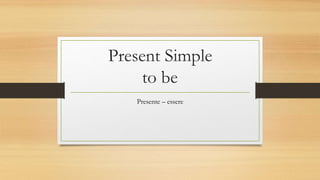
Present simple (to be)
- 1. Present Simple to be Presente – essere
- 2. Present Simple – to be Affirmative Form Forma affermartiva Forma intera Forma contratta I am I’m io sono you are you’re tu sei/Lei è (cortesia) he is he’s egli/lui è she is she’s ella/lei è it is it’s esso/essa è we are we’re noi siamo you are you’re voi siete they are they’re essi/esse/loro sono
- 3. Present Simple – to be Affirmative Form Ricorda che: 1. Si usano quasi sempre le forme contratte nell’inglese parlato e in quello scritto informale (cioè l’inglese parlato tutti i giorni) come le e-mail e le cartoline; 2. Le forme contratte al singolare si possono usare con i pronomi soggetto e i nomi. I’m Sarah. (Io) sono Sarah. You’re English. (Tu) sei inglese. Leila’s is my cat. Leila è il mio gatto.
- 4. Present Simple – to be Affirmative Form 3. Le forme contratte al plurale si possono usare soltanto con i pronomi soggetto plurali (we, you, they). They’re American. (Essi) sono americani. Attenzione! Con i nomi propri si deve usare solo la forma intera del verbo! Tim and Mary are American. Tim e Mary sono americani. e NON Tim and Mary’re Amrican!
- 5. Present Simple – to be Affirmative Form Nota! In inglese il verbo to be e non il verbo to have (avere) per parlare di età. I’m 11 years old. (Io) ho 11 anni. Nota bene: «I’m 11 years old» in italiano lo traduciamo con «Io sono 11 anni vecchio».
- 6. Present Simple – to be Negative Form Forma affermartiva Forma intera Forma contratta I am not I’m not io non sono you are not you aren’t tu non sei/Lei non è (cortesia) he is not he isn’t egli/lui non è she is not she isn’t ella/lei non è it is not it isn’t esso/essa non è we are not we aren’t noi non siamo you are not you aren’t voi non siete they are not they aren’t essi/esse/loro non sono
- 7. Present Simple – to be Negative Form Come si costruisce? Soggetto + am not / ‘m not Soggetto + are not / aren’t Soggetto + is not / isn’t
- 8. Present Simple – to be Negative Form Ricorda che: 1. La forma negativa di to be si ottiene mettendo not dopo il verbo. I am not. 2. La forma negativa contratta di to be si ottiene aggiungendo –n’t alla forma affermativa del verbo. You aren’t He isn’t We aren’t
- 9. Present Simple – to be Negative Form 3. La forma negativa contratta della prima persona singolare si ottiene aggiungendo not dopo la forma affermativa contrata del verbo. I’m not e NON I amn’t
- 10. Present Simple – to be Interrogative Form Forma Interrogativa Risposte brevi Affermative Negative Am I? Yes, you are. No, you aren’t. Are you? Yes, I am. No, I’m not. Is he? Yes, he is. No, he isn’t. Is she? Yes, she is. No, she isn’t. Is it? Yes, it is. No, it isn’t. Are we? Yes, you are. No, you aren’t. Are you? Yes, we are. No, you aren’t. Are they? Yes, they are. No, they aren’t.
- 11. Present Simple – to be Interrogative Form Come si costruisce? Am + soggetto Are + soggetto Is + soggetto
- 12. Present Simple – to be Interrogative Form Come si costruiscono le risposte brevi? Yes, + soggetto + am/are/is No, + soggetto + ‘m not/aren’t/isn’t
- 13. Present Simple – to be Interrogative Form Ricorda che: 1. Nelle domande il verbo to be si trova davanti al soggetto. Are you Italian? NON You are Italian? 2. In inglese, non si risponde ad una domanda soltanto con Yes o No. Si devono usare le risposte brevi. Is it interesting? Yes, it is oppure No, it isn’t.
- 14. Present Simple – to be Interrogative Form 3. Le risposte brevi affermative si formano con Yes + Soggetto + forma intera del verbo to be. Are you Tom? Yes, I am NON Yes, I’m 4. Le risposte brevi negative si formano con No + Soggetto + forma affermativa contratta del verbo to be + n’t tranne alla prima persona singolare che aggiunge not. Are you Tom? No, I’m not.